DRILLING AND WELL COMPLETION
Onshore ERD wells prove RSS effectiveness for Alaska
Optimized point-the-bit RSS with a “matched” extended-gauge drillbit sets a North Slope ERD record.
Chip Alvord, Brian Noel, and Liz Galiunas, ConocoPhillips Alaska Inc.; Vern Johnson and Keith Holtzman, Halliburton Sperry Drilling Services; John Dennis, Halliburton Security DBS and Lee Smith, Alaskan Energy Resources, Inc.
With nearly one million feet of hole drilled in Alaskan North Slope wells using “matched” point-the-bit RSS/extended gauge drilling technology, application of rotary steerable drilling techniques in remote Alpine field development wells has increased reservoir exposure through Extended-Reach Drilling (ERD) profiles. This has resulted in several record slimhole horizontal lengths. Similar in many respects to offshore platform drilling, the Alpine wells demonstrate the potential of rotary steerable drilling techniques for ERD wells offshore.
Beyond enhancing development of new reserves with fewer wells and smaller footprints, using a Rotary Steerable System (RSS) to drill extended-reach lengths can improve production, increase reserves of existing fields, and enable marginal-field development, which has been made economically feasible by the present higher commodity price environment. In the case of the Alpine field’s satellite development wells, the extended lateral exposure has proved additional reserves.
Offshore drilling platforms often dictate hole size and equipment limits; the Alpine wells are drilled from pads that impose similar well-design constraints. In addition, like offshore environments, the remote Alaskan location requires extreme environmental sensitivity and presents unique logistical challenges, Fig. 1.
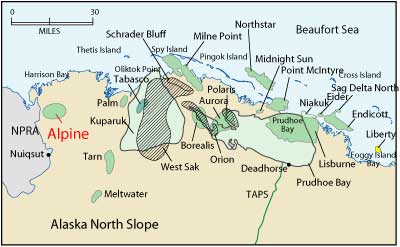 |
Fig. 1. ConocoPhillips is developing Alpine field on Alaska’s North Slope.
|
|
Development of the 40,000-acre Alpine oil accumulation must meet strict environmental regulations, including limiting surface facilities to 97 acres, or two-tenths of one percent of the field area. Such a small site “footprint” severely limits the area available for stockpiling materials.
Beyond limited space, other challenges analogous to offshore drilling include limited materials delivery and resupply to the remote location. With no permanent roads leading to the Alpine field drilling site, transportation of equipment and drilling supplies requires ice roads that can be constructed during winter and allowed to melt in the spring. While this minimizes the environmental impact, it narrows the material delivery window.
Finally, because the site is a near zero-discharge facility, all generated waste must be reused, recycled or disposed of properly, as with offshore operations.
Within these restrictions, the Alpine field was developed using horizontal well technology exclusively to maximize reservoir exposure. Since the field was declared commercial in 1996, more than 600,000 ft of hole has been drilled in some 60 horizontal wells, Table 1. With the introduction of RSS techniques, drilling performance now includes a North Slope record 13,379-ft, 9 7/8-in. RSS/PDC bit run.
| TABLE 1. RSS performance |
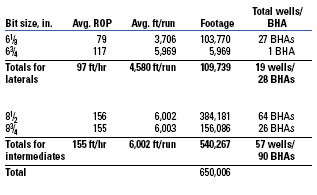 |
|
BACKGROUND
Alpine field, discovered in 1994, is the western-most producing oil field on Alaska’s North Slope. Its geology is different than the huge structures holding Prudhoe Bay and Kuparuk fields. Production is from a stratigraphic trap in the Jurassic Alpine sands with the Kingak Shale as the primary oil source.
The true vertical depth (TVD) of the reservoir averages 7,000 ft, while total measured depths (MD) of the wells range from 9,000 ft to more than 20,000 ft. Enhanced oil recovery is employed to maintain average production of nearly 100,000 bopd.
As the field was developed, increasingly complex and challenging well design has driven a change in drilling practices. Beginning with the 8½-in. intermediate hole section, drilling evolved from use of two steerable BHAs-one using a PDC bit, the other, a rock bit-to a single steerable BHA with PDC bit, and finally to the current practice of drilling the entire section with a single, point-the-bit RSS using extended-gauge PDC bits.
With initial success in the intermediate section, the need to drill even longer and more complex horizontals next led to the application of 4¾-in. RSS tools and 6 1/8-in. extended-gauge, box-up bits in slimhole sections of these wells.
The slimhole RSS was first used in Alpine wells in 2004 and has been used 30 times to date, drilling more than 115,000 ft of 6 1/8-in. to 6¾-in. hole, or approximately 25% of all footage drilled globally with this system.
MATCHED RSS
Drilling was done with a new rotary steerable drilling system, Geo-Pilot, that combined a specially-designed, extended-gauge matched drillbit for point-the-bit drilling. This design deflects a shaft between the bit and the drillstring.
For hole sizes from 8 3/8-in. to 18 ½-in., the larger system sizes use a high-side reference housing containing a compact, rugged, computer-controlled bias unit (eccentric rings) to impart a controlled deflection to the shaft. This allows for continuously variable steering by toolface and effective bend angle.
For hole sizes from 5 7/8-in. to 7-in., the slimhole RSS uses hydraulic power and four pistons that maneuver four wedges over four ramps to deflect the shaft and point the tool, as directed from surface. The advantage of the hydraulic system is that it is much faster than the harmonic gear boxes used in the original systems.
For all tool sizes, the toolface can be set from 0 to 100% in 360° of orientation from highside. Toolface commands are communicated to the tool through mud pulse telemetry, and received and acted upon while drilling ahead. There is no off-bottom time required to reset the toolface.
BIT SELECTION
A key component of the matched RSS is the specially-designed, extended-gauge drillbit that features a gauge length about one and a half times the bit diameter. In a point-the-bit, rotary-steerable drilling mode, the relative length-to-diameter of the extended-gauge design can provide a smoother, maximum-drift directional wellbore without using aggressive cutting structures that can compromise steerability.
At the same time, the extended-gauge bit minimizes non-constructive bit behaviors, maximizing ROP and directional control while drilling. It significantly increases bit and logging tool life and performance, reducing nonproductive trip times.
Because the Alpine drilling environment requires water-base drilling fluid with potential for bit balling, the first bit selection was for a steel-body bit. With the soft tophole section and high ROP expected, a steel-body bit provides flexibility for varying drilling parameters. In particular, it provides flexibility for flow rate variation, which reduces washout during hole cleaning.
By using a steel-body bit with a relatively low HSI (1-2.5/3), high normalized face volume, and an innovative nozzle/hydraulic system, it was possible to increase effective ROP to 200-250 ft/hr for the 8½-in. interval, while maintaining directional control in very soft formations and eliminating bit-balling issues.
A similar bit optimizing strategy was employed for the 6 1/8-in hole interval. As for the intermediate hole, it was important to drill the complete lateral interval with just one bit/BHA since trip time is costly and maximum directional responsiveness is required. Initially, a conservative approach was taken using a six-blade, matrix-body bit set with ½-in PDC cutters. Once a performance baseline was established, a significant increase was realized through design optimization to a five-bladed, steel-body design. By continuous review and improvement, several ongoing design changes are expected to further optimize performance.
As part of a remote site operational philosophy, the Alpine drilling team established a “team approach” that coordinated the efforts and resources of all contractors. In addition to meeting the challenges of remote Arctic operations, this approach increased drilling efficiency, while minimizing logistics and operational costs.
DRILLING OPTIMIZATION
The drilling program used a coordinated service to analyze drilling-related issues and optimize operations. Key data supplied by service company rig site equipment included real-time and historical PWD, vibration, and LWD capabilities. This data was integrated with other data including surface drilling parameters, drilling mud properties and the drilling technique needed to steer the well. This combination supplies the operator with information needed for detailed interpretation related to hole cleaning problems, drag issues and drillstring vibration in specific formations.
REAL TIME OPERATIONS
Real-time access to accurate and detailed drilling data from all sources enables the operator to make changes to the system while measuring the risk and performance of each implementation. For this project, the operator used a Real Time Operation Center (RTOC) in Anchorage for expert drilling optimization support, 24-hr drilling parameters monitoring and Interpolation In-Field Referencing (IIFR) survey provided azimuth corrections.
RTOC also acted as a “lessons learned” hub. Information and experience from one rig was easily transferred to other rigs being monitored. This minimized nonproductive time, ensured data accuracy and increased confidence in the decisions made 800 mi. from the rig.
SURVEYING
Alaska is one of the most challenging areas for accurate surveys because the high latitude presents problems for both magnetic and gyro tools. Surveys are a critical aspect of directional drilling, since they are required to calculate wellbore location. This helps define the reservoir and is critical for anti-collision, when drilling adjacent wells.
Real-time survey monitoring corrects immediately for magnetic interference, whether from the drill string, geological formations or the Earth’s magnetic field. This increases steering efficiency, reduces the ellipse of uncertainty and greatly improves accuracy of the wellbore location. In addition, location accuracy is important for planning future well targets, lowering costs and decreasing the environmental effect.
MWD/LWD
Beginning in early 2006, the Alpine team began using the LWD bi-modal acoustic tool for cement evaluation behind the 7-in. casing on injection wells. Using this state-approved technique for proving isolation eliminated running an electric line cement bond log, saving rig time and money.
Also, the At-Bit-Gamma tool run on the rotary steerable system in the 8¾-in. hole section provided natural gamma ray data 33 ft ahead of traditional technology. This allowed for faster response to geology changes and quicker decision-making while geosteering. Receiving data from sensors 5 ft from the bit makes it possible to position wells within sands a few feet thick and to stay within them.
MUD PROGRAM
The Alpine location is accessible for resupply only three months per year and available storage for stockpiling a year’s supply of drilling fluid materials is limited. The lack of space and high cost for storing base oil were factors that eliminated both synthetic and low-toxicity, oil-base mud from consideration.
Fresh water from nearby lakes is available year round. A low-solids, non-dispersed, fresh water drilling fluid was chosen because of its relative low cost, minimal maintenance product requirements, suitability for formations drilled and relative ease of on-site waste handling.
Mud weights in the intermediate hole section range from 9.6-10.0 ppg. Fast drilling through soft, shallow clays can cause a number of problems including hole washout, bit/BHA balling, and hole-cleaning issues. However, maintaining turbulent flow around the BHA with lowered fluid rheology has helped mitigate these issues.
To save rig time, both the 8½-in. intermediate and 6 1/8-in. production intervals of the wells were drilled with 4-in. drill pipe. While pump pressure limitations sometimes are experienced with longer departure wells, extensive hydraulics modeling optimized fluid rheological properties to achieve a minimum pressure drop in the drillstring, while maintaining good hole cleaning and equivalent circulating density (ECD) control.
The HRZ and Miluveach shale sections, above the Alpine sands can become unstable, especially at higher hole angles, and are stabilized by higher mud weights and treated asphalts. However, due to lower pore pressure on some infill wells, mud weights must be controlled to prevent lost circulation. A glycol-based fluid additive proved effective at increasing shale stability to accommodate lower mud weights and adding particle-sized, graphite-based, plugging material shows promise for mitigating losses.
ERD WELL DESIGN
A directional strategy using RSS allowed maximum wellbore exposure to the target formations with departures lengths growing from 10,000 ft to a record length of more than 18,900 ft on one well, CD2-02, Fig. 2.
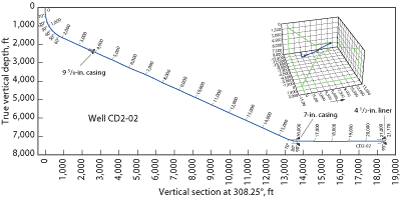 |
Fig. 2. On Well CD2-02, using RSS allowed drillers to produce departures from 10,000 ft to a record 18,900 ft in length.
|
|
A typical well plan for a horizontal producer well has a horizontal section of 8,000 ft, Fig. 3. Midway through the horizontal section at 13,000 ft MD, the wellbore is turned up to 96-98° to penetrate the top of the target sandstone, using LWD with a gamma ray/resistivity/density package to calculate the total net pay thickness. The well is sidetracked at about 13,000 ft MD and reaches TD at 17,483 ft MD.
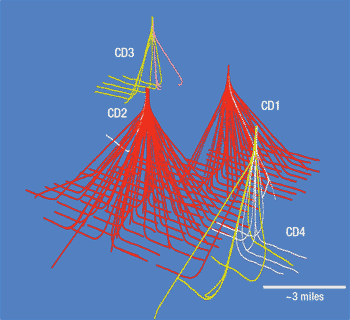 |
Fig. 3. A typical plan for a producer well has an 8,000 ft. horizontal section.
|
|
Well CD3-110 provides an example of challenges overcome and accomplishments made possible by the “drill team” approach to drilling with slimhole RSS technology in this remote application. The original well was drilled to the intermediate section in 2006. Rather than drill a new well on the edge of the reservoir, the operator chose to extend this well, seeking to reach out as far as possible to define the reservoir’s extent. Attempting a 10,000-ft lateral after just two years was considered, based on successes with the slimhole size point-the-bit RSS, as well as the need to define the reservoir’s lateral extent.
The RSS was matched with a five-bladed steel-body bit and run in Well CD3-110 to drill a single record-run of 9,032 ft of 6 ¾-in. lateral before the reservoir pinched out, Fig. 4. Not only did the operation extend the reservoir by several thousand feet compared to offsets, the system drilled record single-day footage of 2,130 ft. It also drilled the third-most daily footage of 1,916 ft.
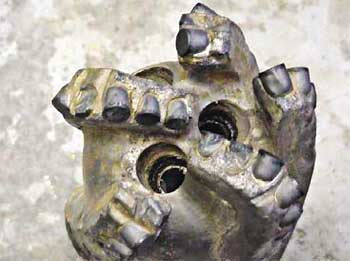 |
Fig. 4 The RSS with a five-bladed steel-body bit drilled a single record-run of 9,032 ft of 6 3⁄4-in. lateral in well CD3-110.
|
|
This performance increased ROP by 44%, drilling at 98 ft/hr compared to 68 ft/hr in offsets, and achieved all objectives in just five days vs the planned 13 days, which resulted in savings to the operator of $1.8 million.
LESSONS LEARNED
While the record performance on well CD3-110 typifies the success realized over the course of this ambitious drilling program, cumulative experience has produced in a number of lessons:
Impact of extreme geometries. An 8,000-ft, 6 1/8in. lateral was attempted on CD3-108, ultimately reaching a length of 7,830 ft. After drilling the lateral, the BHA was tripped to surface where it was discovered that approximately 6,000 ft of the 4-in. drill pipe had worn flat on one side of the connection upsets, Fig. 5. Similarly, the top BHA integral blade stabilizer had one blade worn down to the base.
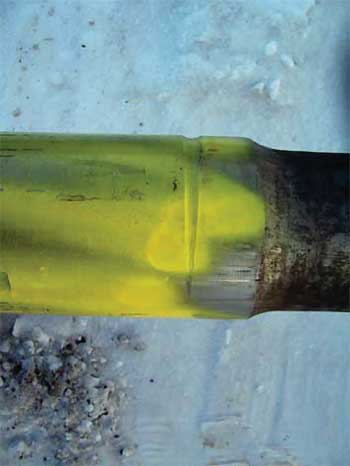 |
Fig. 5. After drilling the lateral, 6,000 ft of 4-in. drill pipe was worn flat on one side of the connection upsets.
|
|
Of three probable root causes for the wear, two were identified through torque and drag analysis; the third was identified through a review of potential drill string dynamics. First, due to the lateral length, fairly shallow TVD, tortuosity and friction, these wells can go to negative down-weight before TD is reached. In such cases, the entire drillstring is in compression while tripping in the hole. The compressive force generates a high propensity for drillstring buckling, which causes further damage, if the drillstring is not picked up far enough to unload the buckled drill pipe before rotation begins. Combined with side forces, rotation of the drill pipe in the buckled helix state can wear flats on one side of the drill pipe connections.
A second probable cause could be a Weight on Bit (WOB) that exceeds the buckling limits of the drillstring. The effective tension can be used to determine the buckling severity by adjusting the drillstring depth to a given point of interest and calculating buckling at that depth. A chart is now used by directional drillers on all Alpine laterals to keep the drillstring out of a buckled state, Fig. 6.
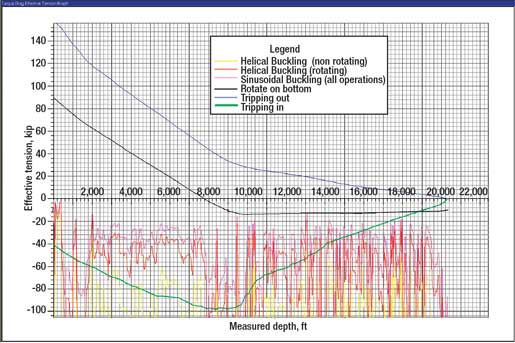 |
Fig. 6. This chart presents the WOB, which would generate sinusoidal or helical buckling at a given measured depth.
|
|
The third probable cause was identified through a drillstring analysis method that calculates BHA-generated harmonics or critical speeds for downhole whirl. A review of drilling parameters showed RPM and WOB combinations that could have generated whirl, while drilling this well. In conjunction with the WOB chart, this critical speed analysis is used by directional drillers to avoid critical speed/WOB combinations that generate downhole whirl.
System limitations. In any application, to maximize RSS performance the advantages and limitations of the total drilling system must be taken into account. Present limitations on use of the slimhole point-the-bit RSS are hot-hole, high-pressure applications, some very soft formations, and build rates exceeding 10° per 100 ft.
Similarly, a systems approach is required to optimize drillbit performance for effective ROP and optimal directional response, with a single bit/BHA completing a full hole interval. While there have been no trips for poor ROP or bit wear issues in Alpine wells to date, there are instances when ROP performance is compromised by opening nozzle total flow area for increased directional response. Optimized bit design ensures the impact in such cases is minimal.
Steerable system advantages. The advantages of using point-the-bit RSS in these extended-reach, horizontal wells included reduced rig time through less drill pipe handling and elimination of short trips, as well as operational benefits like reduced torque and drag, and better control of ECD.
Reduction in rig time for handling drill pipe. The increased step-out and length of the intermediate hole section of these wells initially required use of 5-in. drill pipe to reduce frictional losses and allow for a higher flow rate near TD, with 4-in. drill pipe used in the subsequent 6 1/8-in. hole section. Introduction of the RSS eliminated any need to allow for motor “stall” pressure and made it possible to use 4-in. drill pipe for the intermediate and the production hole sections, reducing the time and cost to pick-up and lay-down the two drillstrings.
Elimination of short trips. In the intermediate hole, the soft clay formations have a tendency to pack along the borehole wall and, and among other things, reduce borehole gauge and increase ECD. With RSS, the constant higher drillstring RPM creates more effective hole cleaning, and enables a string reamer to be run in the drillstring to remove clay buildup while drilling, rather than requiring a dedicated short trip.
Better ECD control. Because of its constant rotation during drilling, the RSS overcomes several operational drawbacks inherent to oriented drilling in highly-deviated wellbores. It overcomes poor hole cleaning, which increases ECD and requires ROP to be controlled while rotating until the allowable ECD limit is restored.
Torque and drag reduction. Finally, the ability of the RSS to drill a smooth, non-spiraled wellbore reduced the measured torque and drag in the intermediate hole section and the subsequent lateral section. Achieving a smoother intermediate hole allows longer laterals with more effective geo-steering through the thinner pay on the edges of the field.
ECONOMIC RESULTS
Perhaps most significantly, the improved efficiencies from applying matched RSS to drill slimhole, extended-reach wells have created a substantial economic impact and provided financial and operational benefits for two new Alpine satellite field developments, presently being drilled. Based on rig-time, savings of $500,000 per well are possible, when each of the two hole sections are drilled with RSS in single trips, Fig. 7.
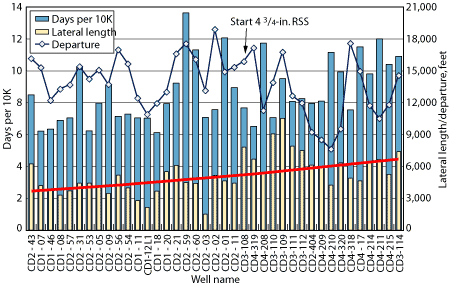 |
Fig. 7. Total savings in Alpine wells have grown due to increased drilling efficiency using RSS; trendline (red) shows rising lateral length.
|
|
Making marginal redevelopment projects more economically feasible by drilling faster and reducing drilling cost, this technology also extends the reach possible from existing structures, eliminating huge capital investments for new structures and extending the useful life of production facilities by restoring production levels.
CONCLUSIONS
Keeping pace with ever-changing oilfield technologies and competently incorporating them into everyday practices has been a fundamental driver in the Alpine field story. Proven in 60 wells to date, the point-the-bit RSS is capable of extending horizontal production sections to reach small targets from existing structures and makes distant flank reservoirs more reachable. The ability to develop new reserves with fewer wells and smaller footprints is critical in environmentally-sensitive locations that can be among the most expensive places in the world.
Application of the technology has proved relevant to offshore environments, such as Cook Inlet wells, and holds promise for other applications, including onshore to offshore drilling, where the RSS extended-reach technology can provide improved oil recovery opportunities. 
ACKNOWLEDGEMENTS
The authors wish to thank ConocoPhillips Alaska Inc., Anadarko, Sperry-Sun, Security DBS, Halliburton Energy Services, Doyon Drilling, MI Drilling Fluids, as well as Alaskan Energy Resources, Inc. for support of this project. We also thank the company men Dave Burley, Donny Lutrick, Don Mickey, Larry Hill, and Nina Woods; directional drillers Ken Harding, Howard Wagoner, Craig Asuchak, Joe Johnson, and Jim Brown; toolpushers Tim Kruppa and John Welsh; as well as Sperry operations support personnel; Sperry MWD operators, Sperry LWD engineers, the drilling crews and service contractors that provide support to the Alpine drilling project. This includes IIFR personnel Jarod Perry, Sean Corinth, Victor Eppler and Kyle Trahan; RTO personnel Randy Krell and Mark Hanik; survey techs Troy Webster and Pete Brougher. We also thank the following personnel from Sperry: Eric Quam, Dave Richardson, Aaron Shanahan, Tom McGuire, and Ryan Thompson at the rig; Troy Jakabosky, Jeff Sack, John Patton, Brij Potnis, Kevin Linebarger, Carey Taylor, Timothy Allen, Eric Cribbs, Michael Haack in town. For Security DBS we thank Dixie Wartner, Mario Rosales, Roy Bobo, Rozena Turner; and for Alaskan Energy Resources: Mike Reece, John Miller, Robert Wright, Bernie Leas and David Egedahl.
BIBLIOGRAPHY
Alvord, C., et.al, “Step change in drilling efficiency: Application of new technology in the Alpine development field,” IADC/SPE 87176, presented at the IADC/SPE Drilling Conference, Dallas, Texas, US, March 2-4, 2004.
McMillin, K., “Rotary steerable systems creating niche in extended reach drilling,” Offshore, February 1999.
Nelson, K., “Drilling in the fast lane,” Petroleum News, June 8, 2003.
Nelson, K., “Expansion will help sustain Alpine field’s crude output,” Petroleum News, Exploration & Production, June 2003.
Vrooman, et.al., “Applications and limitations of steel-body PDC bits,” SPE 20414, presented at the Annual Technical Conference and Exhibition, New Orleans, LA, September 1990.
|
THE AUTHORS
|
|
Chip Alvord earned a BS degree in mechanical engineering from the University of Maine in 1981. He has worked on drilling and production assignments throughout Alaska and in Indonesia and is working on development scenarios for Alpine and NPRA satellite accumulations. Alvord is drilling team lead for Alpine, Cook Inlet and Exploration for ConocoPhillips Alaska, Inc.
|
|
| |
Brian Noel earned a BS degree in geology from the University of Illinois in 1977 and his BS degree in petroleum engineering from the University of Wyoming in 1991. He spent 11 years as a well site geologist in the northern Rocky Mountains and has worked drilling and production engineering assignments. Noel is senior drilling engineer at ConocoPhillips Alaska, Inc.
|
|
| |
Liz Galiunas earned a BS degree in electrical engineering from the Colorado School of Mines in 2004 and has worked in Alaska, holding rig supervisor positions. Galiunas is a drilling engineer for ConocoPhillips Alaska, Inc.
|
|
| |
Vern Johnson earned a BS degree in mathematics in 1992 and a BS in mechanical engineering in 1995, both from Dalhousie University. His work in the Middle East and Alaska included MWD, LWD and multilaterals. Johnson is a drilling engineer for ConocoPhillips Alaska, Inc.
|
|
| |
Keith Holtzman earned an AS degree in heavy equipment technology at the Pennsylvania College of Technology in 1982. He has 17 years of industry experience working in Alaska and East Coast Canada. Holtzman is a directional drilling coordinator for Halliburton, Sperry Drilling Services Alaska.
|
|
| |
John Dennis is a graduate of the University of Texas. He has been involved with bit design applications for over 25 years and started working in Alaska in 1985. Dennis is a chief design evaluation specialist for Security DBS, based in Denver Colorado.
|
|
| |
Lee M. Smith earned a BS degree in geology from University of Utah and a MBA from Oklahoma City University. He has more than 25 years of oil industry experience, has worked in domestic and international management positions, holds more than seven technology patents and has authored more than 20 technical papers and articles. Smith is president of Alaskan Energy Resources, Inc., an agent for Halliburton, Security DBS Drill Bits.
|
|










